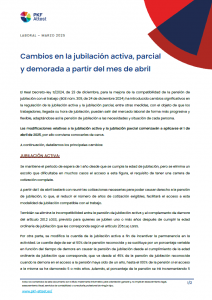Royal Decree-Law 11/2024, of December 23, to improve the compatibility of the retirement pension with work (BOE No. 309, of December 24, 2024) has introduced significant changes in the regulation of active retirement and partial retirement, among other measures, so that workers, when their retirement time comes, can leave the labor market in a more progressive and flexible manner, thus adapting the retirement pension to the needs and situation of each person.
The changes relating to active retirement and partial retirement will begin to apply on April 1, 2025, so it is worth knowing them closely.

The main changes are detailed below:
Active retirement
The waiting period of 1 year from the retirement age is maintained, but a stumbling block that made access to this figure difficult in many cases, the requirement of having a full contribution career, is eliminated.
As of April 1, it will be sufficient to make the necessary contributions to qualify for a retirement pension, which, by reducing the number of years of contributions required, will facilitate access to this form of retirement compatible with work.
The incompatibility between the active retirement pension and the delay supplement of article 210.2 LGSS, provided for those who retire one or more years after reaching the ordinary retirement age that corresponds to them according to article 205.1.a) LGSS, is also eliminated.
On the other hand, the amount of the active retirement pension is modified in order to provide an incentive to remain in the activity. The amount is no longer 50% of the recognized pension and is replaced by a variable percentage depending on the time of delay in obtaining the retirement pension from the ordinary retirement age, ranging from 45% of the recognized retirement pension when the delay in accessing the pension has been one year, to 100% of the pension if access to the pension has been delayed for 5 or more years. In addition, the percentage of the pension will be increased by 5 percentage points for each 12 months of uninterrupted professional activity, without, in any case, exceeding 100% of the pension.
Partial Retirement
The amendment affects the reduction of working hours, which is extended to a maximum of 75% (until now 50%) and the possibility of anticipating the retirement age of Article 215 LGSS is extended from two to three years, with a reduction of between 25% and 75% (until now 50%, and may reach 75% in cases where the relief worker is hired full time with a permanent contract), although in cases of anticipation of more than two years the reduction of working hours allowed during the first year is less, between 20% and 33%.
In turn, in cases of early partial retirement, the relief contracts established will be of an indefinite term and full time nature, and must be maintained for at least two years after the partial retirement is terminated. In addition, the partial retirement modality is now extended to worker or worker-members of cooperatives assimilated to employees.
Regarding the special regulation of partial retirement for workers in the manufacturing industry, the current framework is extended up to and including 2029, with some adjustments to improve the conditions of the relief worker.
Delayed Retirement
The possibility of receiving an additional incentive for every 6 months of delay as from the second year and not only every 12 months is introduced, which represents a greater reward for prolonging working life. Additional measures are also included to improve the conditions of access to retirement for permanent-discontinuous workers. In this sense, the multiplier coefficient of 1.5 for the calculation of benefits such as retirement, permanent disability and death and survival, which was applied in the regulation prior to the reform, is recovered.




